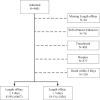Initial prehospital Rapid Emergency Medicine Score (REMS) to predict outcomes for COVID-19 patients
- PMID: 34223444
- PMCID: PMC8240529
- DOI: 10.1002/emp2.12483
Initial prehospital Rapid Emergency Medicine Score (REMS) to predict outcomes for COVID-19 patients
Abstract
Objective: The Rapid Emergency Medicine Score (REMS) has not been widely studied for use in predicting outcomes of COVID-19 patients encountered in the prehospital setting. This study aimed to determine whether the first prehospital REMS could predict emergency department and hospital dispositions for COVID-19 patients transported by emergency medical services.
Methods: This retrospective study used linked prehospital and hospital records from the ESO Data Collaborative for all 911-initiated transports of patients with hospital COVID-19 diagnoses from July 1 to December 31, 2020. We calculated REMS with the first recorded prehospital values for each component. We calculated area under the receiver operating curve (AUROC) for emergency department (ED) mortality, ED discharge, hospital mortality, and hospital length of stay (LOS). We determined optimal REMS cut-points using test characteristic curves.
Results: Among 13,830 included COVID-19 patients, median REMS was 6 (interquartile range [IQR]: 5-9). ED mortality was <1% (n = 80). REMS ≥9 predicted ED death (AUROC 0.79). One-quarter of patients (n = 3,419) were discharged from the ED with an optimal REMS cut-point of ≤5 (AUROC 0.72). Eighteen percent (n = 1,742) of admitted patients died. REMS ≥8 optimally predicted hospital mortality (AUROC 0.72). Median hospital LOS was 8.3 days (IQR: 4.1-14.8 days). REMS ≥7 predicted hospitalizations ≥3 days (AUROC 0.62).
Conclusion: Initial prehospital REMS was modestly predictive of ED and hospital dispositions for patients with COVID-19. Prediction was stronger for outcomes more proximate to the first set of emergency medical services (EMS) vital signs. These findings highlight the potential value of first prehospital REMS for risk stratification of individual patients and system surveillance for resource planning related to COVID-19.
Keywords: COVID‐19; Emergency Medical Services; Patient Outcomes; Prehospital; Retrospective Studies; Risk Stratification; Scoring System; Triage.
© 2021 The Authors. JACEP Open published by Wiley Periodicals LLC on behalf of American College of Emergency Physicians.
Conflict of interest statement
The authors have no conflicts of interest to report.
Figures



References
-
- Saberian P, Tavakoli N, Hasani‐Sharamin P, Modabber M, Jamshididana M, Baratloo A, Accuracy of the pre‐hospital triage tools (qSOFA, NEWS, and PRESEP) in predicting probable COVID‐19 patients' outcomes transferred by Emergency Medical Services. Caspian J Intern Med. 2020;11(1):536‐543. 10.22088/cjim.11.0.536 - DOI - PMC - PubMed
LinkOut - more resources
Full Text Sources
